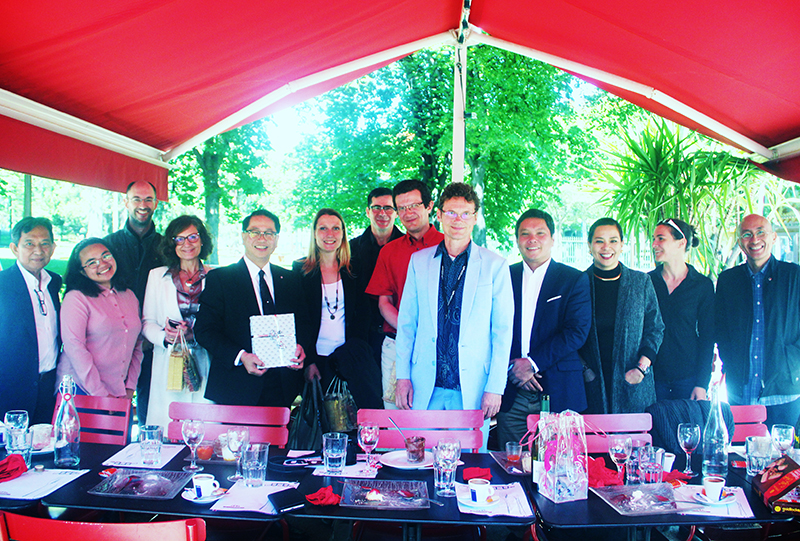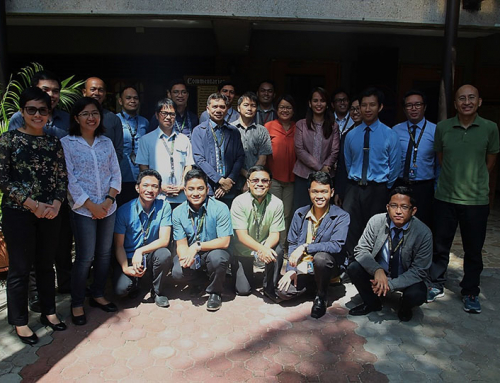University of the Philippines President Danilo L. Concepcion visited Clermont-Ferrand, a university city in the central part of France on 10 -12 May 2018. Pres. Concepcion met with faculty members and administrative staff of Université Clermont Auvergne to discuss areas of further collaboration between the two campuses. Assisting in this meeting were Prof. Mahar A.Lagmay of the National Institute of Geological Sciences, Prof. Rolando G. Talampas of the Asian Center, and Eligio C. Obille of the National Institute for Science and Mathematics Education Development.
The University of the Philippines (UP) and Université Clermont Auvergne(UCA) have enjoyed a long-standing academic cooperation during which numerous faculty and student exchanges have been made. The objective of this particular visit was to explore and expand the possible areas where cooperation can be strengthened, mainly in the field of risk and resilience in relation to natural hazards and climate change. The two universities plan to engage in resilience research through trans-disciplinary programs that cross the boundaries between the sciences, humanities, and arts.
The UP delegation was met at the train station by Prof. Benjamin van Wyk de Vries of the Laboratoire Magmas et Volcans at UCA, accompanied by Prof. John Murray, a visiting researcher from the School of Environment at the Open University in the UK. Upon arrival, the delegation was immediately taken around the city whose rolling streets were built on the slopes of a volcano.The use of lava stones was evident everywhere, most especially in the towering Gothic cathedral that stood out magnificently in the city center.

On top of Gergovie Plateau. UP Pres. Concepcion, M. Lagmay, and G. Concepcion listen to Prof. van Wyk de Vries (second from left) as he explains the geological setting of Clermont-Ferrand. The famous Puy de Dôme volcano looms in the distance.
On the next day, Prof. van Wyk de Vries brought the delegation to the top of the Gergovie Plateau to learn more about the surroundings of Clermont-Ferrand, whose geological setting may be compared to that of certain places in the Philippines. He pointed out various features, among them the Chaîne des Puys, a line of volcanoes surrounding the city, and explained their origin. After a short drive to Ceyrat to take a look at the Limagne Fault, Prof. van Wyk de Vries then brought the group to the Laboratoire Magmas et Volcans for a quick tour.
Over lunch at Pavillon Lecoq, Pres. Concepcion spoke with a number of UCA staff who wanted to learn more about the ways that the two universities could collaborate. A smaller group of people moved later to the Maison des Sciences de l’Homme to discuss about the broad strokes of future cooperation, which would include, among other things, a review of the existing memorandum of understanding,the establishment of learning agreements for student exchanges at the Masters and PhD level, and the provision of assistance in the capacity building of UP faculty.
Prof. van Wyk de Vries and his fellow researchers are excited to find out how this proposal will be met by the global audience, specialists and non-specialists alike. UP NISMED could contribute in the further development of the proposed drawings and exploration of their prospective uses by conducting tryouts of teaching and learning materials where teachers and students will use the geomojis while they learn about Earth and Space concepts as provided by the K to 12 Science Curriculum.
1Geomojis – a symbolic alphabet to communicate Earth Sciences (poster), Benjamin van Wyk de Vries, Dougal Jerram, VladislavRapprich, Andrew Harris, and Dana Martin in theEuropean Geosciences UnionGeneral Assembly 2018,Vienna, Austria, 8–13 April 2018
2 A global framework for the Earth: putting geological sciences in context, Van Wyk de Vries, B., Global and Planetary Change, 2017, https://doi.org/10.1016/j.gloplacha.2017.12.019 (in press)





